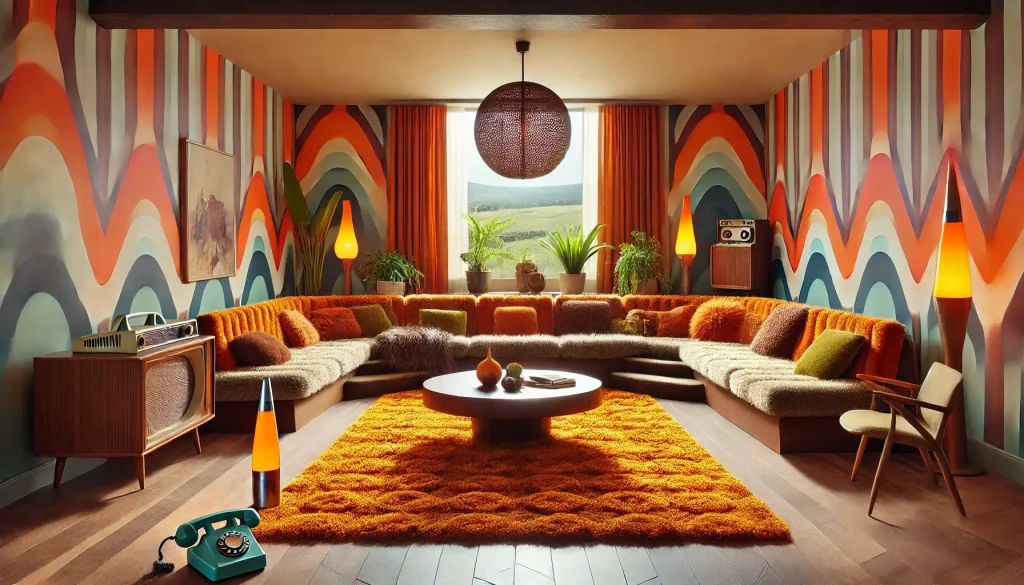The world of interior design has always been a reflection of cultural shifts, technological advancements, and changes in societal values. As we move further into the 21st century, there’s an emerging trend that’s catching the eye of design enthusiasts: the resurgence of 1970s interior design. But is this just a fleeting fascination, or are the bold patterns, earthy tones, and eclectic styles of the ’70s making a full-blown comeback?
The Influence of the 70s: A Nostalgic Return
The 1970s was a decade characterized by a sense of freedom and experimentation. In the design world, this translated into a blend of vibrant colors, geometric patterns, and a mix of textures that were both eclectic and bold. Fast forward to today, and there’s a noticeable shift back to these elements, albeit with a modern twist.
Designers and homeowners alike are drawn to the warmth and character of the 70s aesthetic, particularly in a world that has become increasingly digital and minimalist. The earthy tones, such as mustard yellows, deep oranges, and olive greens, offer a cozy and grounded feel that contrasts with the stark whites and grays of modern minimalism.
Moreover, the use of natural materials, such as wood and rattan, has seen a resurgence as people seek to bring a sense of nature indoors. This trend is not just about aesthetics but also about sustainability and the desire for more environmentally friendly living spaces.
Patterns and Textures: The Bold and the Beautiful
One of the most defining characteristics of 70s interior design is the use of bold patterns and textures. From geometric wallpaper to shag carpets, the decade was anything but subtle. Today, these patterns are making a return, but with a more refined approach.
For instance, geometric designs are now being used in smaller doses, such as accent walls or throw pillows, rather than covering entire rooms. This allows for a touch of retro without overwhelming the space. Similarly, the once-popular shag carpets are being reinterpreted in smaller rugs or as accents, providing texture without the full commitment of wall-to-wall carpeting.
This return to pattern and texture can also be seen in the resurgence of macramé, a craft that was hugely popular in the 70s. From wall hangings to plant holders, macramé is being embraced for its handmade quality and ability to add a tactile element to modern interiors.
Furniture and Décor: A Blend of Old and New
When it comes to furniture, the 70s was all about curves, low-slung seating, and a mix of materials. Today, these elements are being revisited, but often with a contemporary twist. For example, the iconic curved sofa has made a comeback, but with cleaner lines and modern fabrics. Similarly, the use of mixed materials, such as combining metal with wood or glass, is popular once again, reflecting the 70s ethos of blending different styles and textures.
Décor items from the 70s, such as lava lamps and ceramic vases, are also seeing a resurgence. However, they are often used as statement pieces in more neutral settings, allowing them to stand out without overpowering the space. This careful curation of 70s-inspired décor allows for a nostalgic nod to the past while maintaining a contemporary feel.
Sustainability and the Appeal of Vintage
Another reason for the renewed interest in 70s design is the growing awareness of sustainability. The 70s was a decade that embraced the use of natural materials and a return to handcrafted items. Today, this ethos resonates with a generation that is increasingly concerned about the environmental impact of their choices.
Vintage furniture and décor are particularly appealing, as they offer a sustainable alternative to mass-produced items. By repurposing and reusing items from the past, homeowners can create spaces that are both stylish and environmentally friendly. Additionally, vintage pieces often come with a sense of history and character that new items simply can’t replicate.
Modern Interpretations: Balancing Nostalgia and Innovation
While the influence of the 70s is undeniable, it’s important to note that this is not a direct replication of the past. Instead, contemporary designers are taking inspiration from the decade and interpreting it in ways that suit modern lifestyles.
For example, while the 70s were known for their bold use of color, today’s interiors might use these colors more sparingly, as accents rather than the main palette. Similarly, the heavy use of patterns in the 70s is being balanced with more minimalist elements, creating a fusion of old and new that feels fresh and relevant.
This approach allows for the best of both worlds: the warmth and character of the 70s combined with the clean lines and functionality of modern design. It’s a way of honoring the past while looking forward to the future.
Conclusion: A Trend with Staying Power?
So, is 70s interior design coming back? The answer seems to be a resounding yes, but with some important caveats. This is not a return to the 70s in its purest form, but rather a reinterpretation of the decade’s most beloved elements. By blending the old with the new, designers and homeowners are creating spaces that feel both nostalgic and contemporary.
As with any trend, the key to its longevity will be its ability to adapt and evolve. The 70s aesthetic, with its emphasis on natural materials, bold patterns, and a mix of textures, seems well-suited to do just that. Whether you’re a fan of the era or simply looking for a way to add some character to your home, the influence of the 70s is likely to be felt for years to come.

